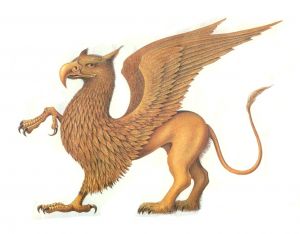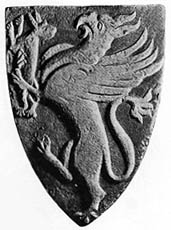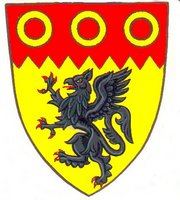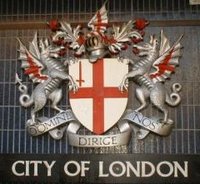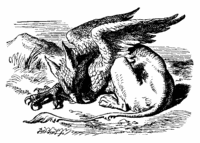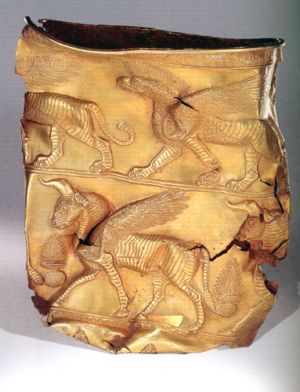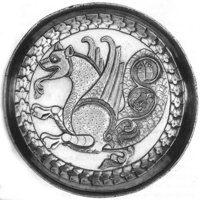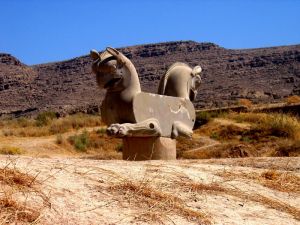(→Nature) |
|||
| Line 8: | Line 8: | ||
=Nature= | =Nature= | ||
Griffins are believed to have lived in groups ranging from 5 to 25 or 30 members. The group lived in a hierarchy very similar to modern day lions. The oldest and strongest male used to be the head of the group. | |||
Griffins were believed to have hunted in packs of around 15 members over the extent of their territory, which depended on the area where the griffins resided. In a hospitable environment, the griffins territory could be very small, only a few kilometers in a radial direction. While if the griffins lived in a harsh environment, their territory could could possibly extend for a few hundred or even a few thousand kilometers in a radial direction. | |||
==Etymology== | ==Etymology== | ||
| Line 113: | Line 114: | ||
The griffin was said to inhabit the Scythia steppes that reached from the modern Ukraine to central Asia; there gold and precious stones were abundant; and when strangers approached to gather the stones, the creatures would leap on them and tear them to pieces. The Scythians used giant petrified bones found in this area as proof of the existence of griffins and to keep outsiders away from the gold and precious stones. It has recently been suggested that these "griffin bones" were actually dinosaur fossils, which are common in this part of the world. | The griffin was said to inhabit the Scythia steppes that reached from the modern Ukraine to central Asia; there gold and precious stones were abundant; and when strangers approached to gather the stones, the creatures would leap on them and tear them to pieces. The Scythians used giant petrified bones found in this area as proof of the existence of griffins and to keep outsiders away from the gold and precious stones. It has recently been suggested that these "griffin bones" were actually dinosaur fossils, which are common in this part of the world. | ||
=History/Beliefs= | =History/Beliefs= | ||
Revision as of 14:27, 24 February 2008
The Griffin is a legendary creature with the head, beak and wings of an eagle, the body of a lion and occasionally the tail of a serpent.
Nature
Griffins are believed to have lived in groups ranging from 5 to 25 or 30 members. The group lived in a hierarchy very similar to modern day lions. The oldest and strongest male used to be the head of the group. Griffins were believed to have hunted in packs of around 15 members over the extent of their territory, which depended on the area where the griffins resided. In a hospitable environment, the griffins territory could be very small, only a few kilometers in a radial direction. While if the griffins lived in a harsh environment, their territory could could possibly extend for a few hundred or even a few thousand kilometers in a radial direction.
Etymology
From the Greek gryphos, Persian شیردال shirdal "lion-eagle"
Spelling variants
Griffin has been spelled various ways: gryphon, griff, griffen, griffon, griffoun, griffun, griffyn, grifo, grifon, grifyn, grefyne, gríobhán, griphin, griphon, gryffen, gryffin, gryffon, gryfon, gryf, gryphen, and gryphin.
Lore
The Griffin was known in Egypt before 3300 BC and is possibly more ancient still. Pliny believed griffins came from Northern Russia; Aeschylus thought they originated in Ethiopia; and Bulfinch wrote that their native country was India. Herodotus said that legends of griffins came from the Issedonians who lived beyond the Oural Mountains. Biedermann wrote later that it has typological antecedents in ancient Asia, especially in the Assyrian k'rub, which is also the source of the Hebrew cherub.
Description
The griffin or gryphon is a mythical quadruped with the foreparts of an eagle and the rear, tail and hindquarters of a lion. Its eagle-like head had pointed, upstanding ears like those of an ass. Feathers grew upon its head, neck and chest and the rest of the griffin’s body was covered in leonine fur, subtly colored in shades of tawny brown. Aelian said the wings of griffins were white and their necks were variegated in colour with blue feathers. The griffin claws were especially valuable as they were reputed to change color in the presence of poison, which is why they made useful drinking vessels. At times, it is portrayed with a long snake-like tail. In some traditions, only the female has wings.
As the lion was considered the "King of the Beasts" and the eagle the "King of the Air", the griffin was thought to be an especially powerful and majestic creature.
Classical and heraldic griffins are male and female. A "male" griffin, called a keythong in a single 15th century English heraldic manuscript, is an anomaly that belongs strictly to a late phase of English heraldry: see below.
Family
There are a number of different types of griffins;
- The snake-griffin has a lion’s body, a snake’s head and a bird’s legs;
- The lion-griffin is lion-like but has hind legs shaped like those of a bird.
- The Hypogriffin or Hypogriff is a mix of a griffin and a horse.
The hippogryph, living far beyond the seas in the Rhiphaean Mountains, is the result of the rare breeding of a male gryphon and a filly. It has the head, wings and front legs of a gryphon, and the back and hind legs of a horse. It is a large powerful creature that can move through the air more swiftly than ligthning. It figured in several of the legends of Charlemagne as a mount for some of the knights.
Heraldic griffins
A heraldic griffin (or gryphon) has the hind parts (including legs and tail) of a lion, the upper parts (including feathered neck, wings, claws, and head with beak) of an eagle and also ears. It is the ears which distinguish the griffin's head from an eagle's head in heraldry, which is important because, as well as the full griffin, the griffin's head is also often found in heraldry and would otherwise be identical to the head of the eagle.
According to the Tractatus de armis of John de Bado Aureo (late fourteenth century) “A griffin borne in arms signifies that the first to bear it was a strong pugnacious man in whom were found two distinct natures and qualities, those of the eagle and the lion”. This is clearly fanciful, but since the lion and the eagle were both important charges in heraldry, it is perhaps not surprising that their hybrid, the griffin, was also a frequent choice. The symbolism of the lion-eagle combination was also the subject of a quotation attributed to Chassaneus by Alexander Nisbet in his System of Heraldry (1722; p 343 of Vol I of the 1816 edn): "Gryphus significat sapientiam jungendam fortitudini, sed sapientiam debere praeire, fortitudinem sequi.". This translates as: “The griffin represents wisdom joined to fortitude, but wisdom should lead, and fortitude follow".
Heraldic griffins are usually shown rearing up, facing left, and standing on one hind leg with the other leg and the claws raised: this posture is described in the Norman-French language of heraldry as "segreant", a word uniquely applied to griffins, and which is the exact equivalent of the description of lions and other creatures in heraldry as "rampant".
The City of London adopted what are usually described as griffins as supporters for its coat of arms, and it marks its boundaries with statues of a single "griffin" carrying the City coat of arms at each road leading into the City of London. However, the City of London griffins are, in fact, heraldic dragons, with scaly bodies and wings, no feathers, and no eagle's beak.
The "keythong"
The heraldic beast called a "keythong" much enjoyed among members of the Society for Creative Anachronism is claimed to appear in a single English manuscript of the reign of Edward IV of England, a heraldic solipsism. J.R. Planche's Pursuivant of Arms (London 1859) notes, under the badge of the Earl of Ormonde (first creation) as recorded in a College of Arms manuscript under Edward IV, the single contemporary reference: "A pair of keythongs." Planche's footnote: "The word is certainly so written, and I have never seen it elsewhere. The figure resembles the Male Griffin, which has no wings, but rays or spikes of gold proceeding from several parts of his body, and sometimes with two long straight horns. Vade Parker's Glossary, under Griffin." (Society of Creative Anachronism website). At the end of the 20th century the "keythong" began to be taken up enthusiastically among amateurs of heraldry.
Behavior
A 9th century Irish writer by the name of Stephen Scotus asserted that griffins were highly monogamous. Not only did they mate for life, but if one partner died, the other would continue throughout the rest of its life alone, never to search out for a new mate. The griffin was thus made an emblem of the Church's views on remarriage.
The egg-laying habits of the female were first clearly described by St. Hildegard of Bingen, a German nun author of the 12th century. She outlined how the expectant mother would search out a cave with a very narrow entrance but plenty of room inside, sheltered from the elements. Here she would lay her 3 eggs (about the size of Ostrich eggs), and stand guard over them.
Its nests are made of gold and its eggs resemble agates. It is supposed to be of gigantic proportions, the morphology being left to our own deduction after we have been informed that one claw is the size of a cow's horn.
Role
Because of the griffin's strength and powers of sight, it was believed to guard hidden treasures and in particular the vast gold mines of India and Scythia. The Arimaspians, a bold, one-eyed race of humans, constantly tried to steal their treasure and eventually drove the griffins away the mountains. Because of its association with the Holy Grail, one of the treasures most commonly guarded by griffins was emeralds. Other popular treasures guarded by griffins were the Tree of Life, knowledge, and the roads to salvation. Greeks and Romans used griffin images to guard tombs.
Powers
In its body, the griffin is blessed with the speed, flight, and penetrating vision of the eagle and the strength, courage, and majesty of the lion.
Enemy
The horse is its fiercest enemy. The griffin also became the adversary of serpents and basilisks, both of which were seen as embodiments of satanic demons.
Places
The griffin was said to inhabit the Scythia steppes that reached from the modern Ukraine to central Asia; there gold and precious stones were abundant; and when strangers approached to gather the stones, the creatures would leap on them and tear them to pieces. The Scythians used giant petrified bones found in this area as proof of the existence of griffins and to keep outsiders away from the gold and precious stones. It has recently been suggested that these "griffin bones" were actually dinosaur fossils, which are common in this part of the world.
History/Beliefs
Authors
Tales of griffins and the Arimaspi of distant Scythia near the cave of Boreas, the North Wind (Geskleithron) were elaborated in the lost archaic poem of Aristeas of Proconnesus, Arimaspea, and eagerly reported by Herodotus and in Pliny's Natural History.
Culture
In Ancient Egypt, the griffin was depicted with a slender, feline body and the head of a falcon. Early statuary depictes them with wings that are horizontal and parallel along the back of the body. During the New Kingdom, depictions of griffins included hunting scenes. Divine figures in egyptian mythology, despicted as griffins, include Sefer, Sefert, and Axex.
Ancient Elamites used griffin symbol extensively in their architecture. In Elam legends, a Griffin was presented to Elamite Gods. In Persian mythology, in particular during the Achaemenid dynasty, griffins called Homa (mythology)|Homa were used widely as statues and symbols in palaces. Homa also had a special place in Persian literature as guardians of light.
Both Persians and Assyrians decorated with images of this magical beast. Images of two griffins drinking from a flaming cup were common in the Persian religion, Zorastrianism.
Romans used them for decoration and even in Christian times griffins were frequently used as gargoyles on medieval churches and buildings.
In architectural decoration the griffin is usually represented as a four-footed beast with wings and the head of a leopard or tiger with horns, or with the head and beak of an eagle. The griffin is the symbol of the Philadelphia Museum of Art and you can see bronze castings of them perched on each corner of the museum's roof, protecting its collection.
The creature appeared as frequently in the applied arts (tapestries, the work of goldsmiths) as in heraldry. In the latter domain, Boeckler (1688) offered the following interpretation: "Griffins are protrayed with a lion's body, an eagle's head, long ears, and an eagle's claws, to indicate that one must combine intelligence and strength."
A griffin (spelled "gryphon") is featured in Lewis Carroll's Alice's Adventures in Wonderland in which the Queen of Hearts' orders the gryphon to take Alice to see the Mock Turtle and hear its story. The original illustrations by Sir John Tenniel depict the gryphon in an unusually naturalistic style .
Some large species of Old World vultures are called gryphons, including the griffon vulture (Gyps fulvus), as are list of dog breeds|some breeds of dog (griffons).
The scientific species name for the Andean Condor is Vultur gryphus; Latin for "griffin-vulture".
Stories
Apollo rode a griffin and according to greeks, griffins guarded the gold of the Hyperboreans in Scythia.
One legend involving griffins is the Ascension of Alexander the Great. According to this story, Alexander captured a pair of griffins and, having starved them for three days, hitched them to his throne and, teasing them with chunks of roast beef held above their heads on lances, flew heavenward for seven days. Alexander would have stolen a peek at God Himself if an angel had not asked him why he wanted to see the things of heaven when he did not yet understand the things of earth. Chastised for his presumptuousness, Alexander flew back to earth. Representations of Alexander's ascension were placed in French and Italian cathedrals during the 12th century.
During the Middle Ages, Christian nobles searched for griffin's eggs or "grypeseye" which they mounted and used for cups, believing they brought health to any beverage.
Theories and analysis
Theories about origin and existence
Adrienne Mayor, a folklorist, has made tentative connections, in Fossil Hunters: Paleontology in Greek and Roman Times, between the rich fossil beds around the Mediterranean and across the steppes to the Gobi Desert and the myths of griffins, centaurs and archaic giants originating in the classical world. Mayor draws upon striking similarities that exist between the Protoceratops skulls of the steppes leading to the Gobi Desert, and the legends of the gold-hoarding griffin told by nomadic Scythians of the region; among the artistic evidence, the 6th century Greek vase on the book's cover is incontrovertible. The size of that fossil skull may be the source of the claim that a griffin is eight times the size of a lion.
Symbol
Griffin was consecrated to the Sun; and ancient painters represented the chariot of the Sun as drawn by griffins. In symbolism, the griffin combines the symbolic qualities of two solar creatures, the lion and the eagle. It is the king of birds and lord of the air united with the king of beasts and lord of the earth. Griffins are a symbol of the sun, wisdom, vengeance, strength, and salvation.
The griffin's ability to soar like an eagle made him an emblem of poetic and spiritual inspiration. The griffin was also an embodiment of Nemesis, the goddess of vengeance and retribution, and turned her wheel of fortune.
The griffin's dual nature led it to be associated with Jesus Christ, God and man, king of heaven and earth. The eagle half of the griffin signified Christ's divinity and the lion half represented his humanity. During the Middle Ages, griffins were symbols of Christ's resurrection. The strength of the lion and the wisdom of the eagle combined in the griffin symbolized the strength and wisdom of God.
Nevertheless, the ambivalence of his nature, led some people to see in the griffin the perversion of the strengths of both animals. Gevaert theorized that the combination of lion and eagle parts would more or less cripple the griffin, depriving him of the ability to fly unencumbered like the eagle or walk nobly like the lion. It was associated with those who used their powers to persecute the Christians, evil personified, the Antichrist, and the Devil. There was even an imaginary creature called the griffin-dragon who had the tail of a dragon or a snake. This one always represented evil.
Art/Fiction
Griffins in literature
- A griffin ghost-writes myth and legend novels and reads stories to children at a local library in Collinsfort Village by Joe Ekaitis.
- Alice's Adventures in Wonderland|Alice in Wonderland by Lewis Carroll (see reference in summary above)
- In Neil Gaiman's Sandman comic book series, a griffin is one of three guardians of Morpheus' palace in The Dreaming
- Griffin is Monster in My Pocket #5.
- The Crossroads series by Nick O'Donohoe, including The Magic and the Healing, Under the Healing Sign, and Healing of Crossroads. Griffins play a significant role in this series about veterinary students called upon to help mythological creatures.
- Three varieties of griffins, with different spellings and very different dispositions, appear in the popular children's novel David and the Phoenix by Edward Ormondroyd.
- Minor Harry Potter Beasts are among the magical creatures that exist in the Harry Potter series. Harry Potter's house (i.e., grouping of pupils) at Hogwarts School of Witchcraft and Wizardry is called Gryffindor, after its founder Godric Gryffindor. "Gryffindor" may come from the French "gryffon d'or" or "golden griffin", but, oddly, its emblem is a lion and not a griffin. The gargoyle guarding the Hogwarts headmaster's office is depicted in the Harry Potter movies as a half-phoenix, half-lion griffin.
- The Griffin and the Minor Canon by Frank R. Stockton, illustrated by Maurice Sendak (1968)
- Gryphons are among the creatures in Aslan's army in The Chronicles of Narnia.
- The Mage Wars Trilogy by Mercedes Lackey and Larry Dixon. A gryphon known as Skandranon is one of the lead characters. Titles are The Black Gryphon, The White Gryphon and The Silver Gryphon.
- The Divine Comedy by Dante Alighieri. A griffin pulls the chariot which brings Beatrice to Dante in Canto XXIX of the The Divine Comedy Purgatory.
- Revenge of the Shadow King by Derek Benz and J.S. Lewis
- A human baby turns into a griffin in Wilanne Schneider Belden's Frankie!
- Griffins play a part in the Dragonlance novels, under the command of Elves.
- In the Eberron campaign setting for Dungeons & Dragons, the griffon is the heraldic beast of the dragonmarked Dragonmarked house#House Jorasco|House Jorasco.
- In The Once and Future King by T. H. White, young King Arthur|Arthur and his step-brother Sir Kay|Kay battle a fierce griffin with aid from Robin Hood soon after freeing captives of Morgan le Fay.
- In Baldur's Gate 2, the gnome NPC Jan Janssen's family (according to him) has had a number of encounters with griffins, mostly as a food source. One spoken line from the character is a panicked 'what? Is there a griffin about?"
- In The Divide trilogy, by Elizabeth Kay, griffins are called brazzles. The males are mathematicians, and the females are historians. The brazzles Ironclaw and Thornbeak appear in all three books; they are highly intelligent, obsessed with their own careers, and bicker like an old married couple.
External links
- The Gryphon Pages, a comprehensive collection of all things pertaining to gryphons, from history and literature, to heraldry, to art both ancient and new.
- Griffins in Art and on the Web, an "art history through griffins"
- Greek Mythology Link Bestiary: Griffin, quoting Herodotus, Pausanias, Strabo
- Fossil Hunters: Paleontology in Greek and Roman Times
- Lady Gryphon's Mythical Realm: Griffin Aerie
- Beasts of Ancient Egypt
- The Official Gryphon's Guild
- Gryphons on GryphonWiki

